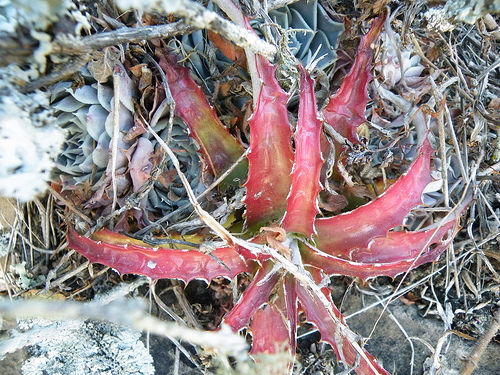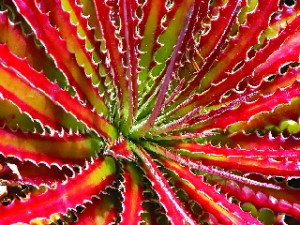Introducing Hechtia: A Bromeliad of a Different Variety
Author: Melanie Dearringer1 Comment
Care and Culture, Classification, Growing Outdoors

Hechtia is a small genus of bromeliad. While many other bromeliad genera have hundreds of species, Hechtia boasts only fifty. There are several unique features to the Hechtia genus that makes it stand out among other bromeliads. Many of these features make them excellent landscaping or outdoor container plants.
HECHTIA: NATIVE REGIONS
Most bromeliads are native to tropical regions. They originate from Florida to Brazil in moist, forested regions and are primarily native to Mexico. This home range gives Hechtia special adaptations that make them tough and allows them to handle conditions other bromeliads will not.
ARE THEY SUCCULENTS?
Hechtia can be found natively in areas that are primarily arid. They thrive in bright, sunny deserts. Hechtia are not succulents, but they can be treated as such. They do not hold water in their tissue the way true succulents do. Instead, they slow their growth when water is not available.
TERRESTRIAL
Hechtia are terrestrial and should be potted or planted in the ground instead of mounted. Their sandy, rocky home terrain should be mimicked when planted. Use gritty potting mix that is well draining. Adding some coarse sand, perlite, or small stones to regular potting mix should provide appropriate drainage for these plants.
VARYING TEMPERATURES
Hechtia tolerate colder temperatures than other bromeliads. Most bromeliads have a small range of temperature in which they will thrive. This is usually between 60 and 80 degrees. Hechtia can survive in both extremely hot temperatures and cold temperatures, down to 20 degrees, for short periods of time. This genus actually prefers a strong temperature shift between night and day. Because these plants have grown accustomed to temperature swings because of their native desert homes, it is best if the temperature drops around 15 degrees from day to night.
WATER
Hechtia do not require humidity and, therefore, do not require misting. To keep them growing quickly and healthily, water them regularly during the spring and summer growing season. Allow the potting mix to dry a bit between waterings, as too much water can cause rot. In the winter, hold back on the water. It is better for the plant to be too dry than too wet.
LIGHT
Hechtia love sunlight. They are tougher than other bromeliads which are usually burned by direct sunlight. Hechtia have special scales on their leaves that reflect the sun to prevent burning. They can survive in up to 50% shade, but their unique, bright colors will not be as vivid and flowering may be prohibited. They can be grown indoors, but it is often difficult to find an indoor space that provides enough bright sunlight. For the best results, Hechtia should be planted where they will get as much sunlight as possible. This is one reason Hechtia are better suited for outdoor landscaping than indoor plants.
SIZE
Some of the Hechtia species can grow incredibly large. According to Bromeliad Society/Houston, Hectia melanocarpacan grow a rosette up to five feet across and produces a flower stalk that can reach eight feet tall. There are other species, such as Hechtia lyman-smithii that are much smaller. These small species grow only 5 or 6 inches wide, but often form large tight clumps.
Hechtia will usually grow as large as the container they are planted in. When planted as a pup, these bromeliads grow quickly and should be repotted every year until they reach maturity. It can take up to three years or more for a plant to reach maturity.
BLOOMING

via amantedar
Most bromeliad species flower only once and then die. Hechtia can flower multiple times and continue growing and producing pups. They produce long flower stalks that grow out of the sides or center of the plant. Most Hechtia flowers are not very showy. They are generally planted for their interesting foliage. As the plants grow and mature, the tips of the leaves may begin to turn brown. This is not a sign of damage, but a normal occurrence. You can trim away the brown segments or leave them in tact. Neither technique will harm the plant. It is simply a matter of your preference in the appearance of the plant.
Another unique fact about Hechtia flowers is that they can be identified as either male or female. Other genera of bromeliads have perfect flowers containing both male and female parts. Hechtia flowers are imperfect. They are always either male or female. This does not make much difference in the care or appearance of the flowers. However, if you want to propagate them from seed you must have one of each.
RECOMMENDED SPECIES
Hechtia texensis
Like its name suggests, this bromeliad is native to Texas. It will thrive well when planted in outdoor xeriscapes. The plant can grow as large as 18 inches across and can produce a flower stalk as tall as 2 feet. It becomes bright red toward the outer edges of the thin leaves and yellow-green towards the center. It has sharp white teeth that surround its leaf margins. Strange Wonderful Things recommends fertilizing regularly for the first 2-3 years of growth. This will help it reach full size quickly. This plant also pups generously and can create large, full looking clumps.
Hechtia caerulea
This is a small bromeliad with thin, long, bright green leaves. The leaves drape downward making this plant ideal for hanging planters. It also has very few spines, making it slightly less dangerous to hang than other Hechtias. Hechtia epigyna and Hechtia lundelliorum will also work wonderfully as hanging plants. The Hechtia lundelliorum is entirely toothless and produces lovely white flowers.
Hechtia glauca
This plant has some of the thickest leaves in the Hechtia genera. They are leathery and succulent looking. They are a beautiful turquoise color with a silvery powdered coating. They can grow up to 18 inches across.
Hechtia montana
Hechtia montana is a very hardy large growing plant. It is ideal for large outdoor landscaping spaces. The plant is a dark green with sharp white teeth.
Hechtia rosea
This bromeliad is one of the few Hechtias that boasts beautiful flowers. It produces a tall flower stalk with attractive pink/red flowers. The foliage also blushes red at the center when flowering.
LANDSCAPING
Hechtia are perfect for your landscaping if you live in a hot dry climate. They will withstand the extreme temperatures and bright hot sun. These plants pair well with other outdoor plants such as agaves, yucca, and cacti. Their bright colored foliage and distinctive spikes will be an attractive and easy addition to your garden.
You can also grow Hechtia in any climate in a well draining container. Make sure they don’t stay too wet and they are protected in extreme cold. Their rosette shape makes them ideal for large container arrangements.
WHERE TO BUY HECHTIA
Purchasing Hechtia can be a little more difficult than other bromeliad species as they can be hard to find. If you would like to try your luck with one of these truly unique bromeliads, you may want to visit a specialty nursery or online retailer. Annie’s Magic Garden and Tropiflora are both online retailers have an excellent selection of Hechtia. For more on where to buy bromeliads see The Essential Bromeliad Buyers Guide.
Have you used Hechtia in your plantscaping designs? Let us know how they turned out.
Sources
“Hechtia” Bromeliad Society/HoustonHechtia” Annie’s Magic Garden
“Hechtia texensis” Strange Wonderful Things
Hechtia: The Perfect Bromeliad for Desert LandscapingPhoto “Hechtia texensis” courtesy of Stan Shebs.
One response on “Introducing Hechtia: A Bromeliad of a Different Variety”
Leave a Reply

Resource Download
Hechtia Care Cheat Sheet
Learn how to care for your Hechtia bromeliad with this quick and easy informational guide.
Learn More
Ask an Expert
Questions about bromeliads?
Our experts love a challenge!
Photo of the Week
Submit your photo to be featured on the blog!
More Photo of the Week Winners
Submit Photo









Very good article! I enjoyed reading all of it.